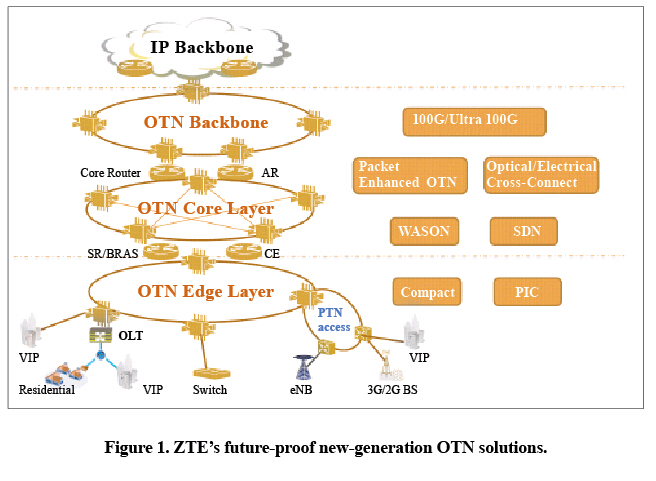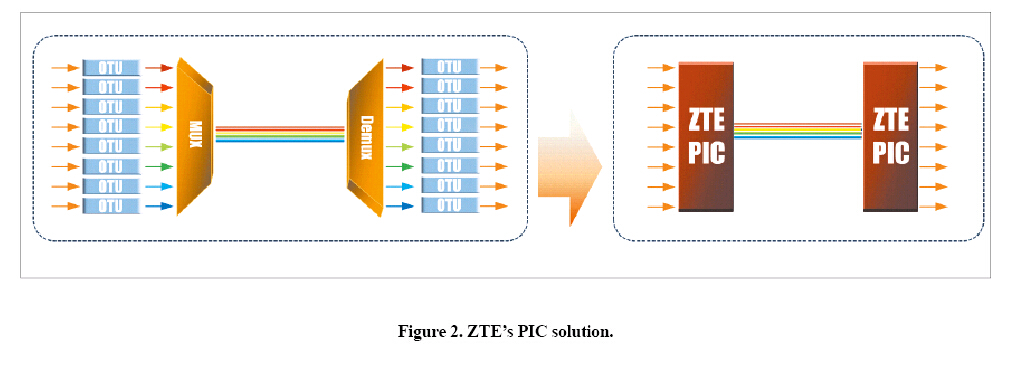ZTE’s New-Generation OTN Solutions
Challenges for OTN
In the booming mobile internet era, operators are facing huge opportunities and challenges. The demand for mobile bandwidth is growing exponentially as a result of the wide deployment of LTE networks. In the fixed broadband segment, video services such as IPTV and HDTV have driven a huge demand for bandwidth. China has unveiled a national broadband plan and has drawn up a specific timetable for greatly improving user access bandwidth. In recent years, governments and enterprises have experienced rapidly growing demand for bandwidth. Addressing bandwidth overlapping is the biggest challenge for mobile operators.
Mobile operators are also troubled by the “scissors difference” phenomenon. They have to invest heavily in network construction every year to respond to enormous bandwidth growth. They also must face slow growth in revenues and squeezed profits. Improving network resource utilization and reducing network deployment and maintenance costs constitute a second group of important challenges for mobile operators.
Moreover, user experience is of vital importance in a fiercely-competitive market. Only a high-quality optical transport network (OTN) can ensure high-speed user experience anytime, anywhere. Quick service deployment, flexible service scheduling, and service security constitute a third important group of challenges for mobile operators.
ZTE’s Future-Proof New-Generation OTN Solutions
With a deep understanding of operator requirements, ZTE has rolled out future-oriented new-generation OTN solutions that cover all network layers (Fig. 1). The solutions help operators build a high-bandwidth, high-efficiency, high-speed, highly flexible, secure, intelligent transport network.

Core Backbone Layer
In the core backbone layer of an OTN, upper-layer routers or PTN devices are evolving to have high-speed ports. Current routers usually provide 10G or 40G ports, and 100G ports are gradually being put into commercial use. OTN serves as a bottom-layer transport platform that needs to adapt to the evolution of ports of upper-layer devices; therefore, 100G OTN has gradually become the only choice for the core backbone layer, and 400G OTN will be unveiled for commercial use. Although large-capacity OTN improves system capacity and spectrum efficiency, traditional OTN provides rigid-bandwidth pipes that make it difficult to optimize service management and maximize transmission. Therefore, incorporating packet functions into an OTN platform can improve bandwidth efficiency and network flexibility.
Moreover, the WASON intelligent control plane can further improve OTN intelligence, reduce OAM difficulty, and ensure service security through a unique protection mechanism. In the future, WASON will smoothly evolve into software-defined network (SDN) architecture that can dynamically adjust optical transmission resources through software to further improve network efficiency.
100G and Ultra 100G OTN
ZTE’s 100G OTN solution adopts coherently-detected PM-QPSK and industry-leading DSP algorithm. It also supports SD-FEC and HD-FEC. The solution has superior transmission performance that enables a radio repeater transmission distance of over 3500 km without the need for chromatic dispersion compensation and PMD compensation. This saves investment and makes OAM easier. An advanced 28 nm AISC chip is also used to improve system integration and greatly reduce power consumption. ZTE’s 100G OTN solution has been widely applied around the world.
ZTE’s ultra 100G OTN solution uses industry-leading QAM and multi-carrier technologies. The solution is capable of long-haul transmission of 11.2T, 24 × 1.3T, 40 × 400G, and 20 × 440G with a single channel. ZTE has also cooperated with German Telecom to complete a 1750 km ultra-long-distance hybrid transmission of 100G, 400G, and 1T signals in Germany.
Ultra-Large-Capacity Packet OTN
ZTE’s new-generation ultra-large-capacity packet OTN solution (ZXONE 9700) is designed for a shared 100G and ultra 100G platform. Based on the general-purpose cell cross-connect platform, ZXONE 9700 provides a converged optical packet layer architecture that supports unified wavelength, OTN, and packet cross-connect platform and provides both rigid and flexible transmission pipes.
A single ZXONE 9700 subrack provides the largest cross-connect capacity and the largest number of slots in the industry. The electrical cross-connect capacity of 14.4T (72 slots) can be smoothly evolved into 28.8T, and the current transmission rate of 100G can be smoothly increased to 400G.
Intelligent WASON and SDN
ZTE’s intelligent solutions include WASON and SDN. The WASON solution (ZXUCP A200) based on an optical and electrical cross-connect platform can automatically update and maintain network information and schedule traffic for effective end-to-end service configuration. This reduces manpower. As the core-layer network topology is evolving toward MESH, ZXUCP A200 can also provide multiple classes of services and protect against fiber disconnection in order to greatly improve network security. The SDN solution uses software to control a network. The network architecture consists of application layer, control layer, and transport layer. Leveraging the advantages of WASON and PCE, the control layer can be smoothly evolved to SDN architecture. The transport layer based on software-defined optical (SDO) and fex-grid technologies enables groupware, devices and the network to be programmable and adaptable to changes in services and scenarios.
MAN Edge Layer
There are many mobile sites at the MAN edge layer. The communication distance between these sites is short, and the sites are usually located in remote areas with poor equipment rooms. Therefore, it takes a long time to deploy services, and maintenance work is also difficult. To address these issues, ZTE has launched miniature OTN and PIC solutions.
Miniature OTN
ZTE’s new-generation miniature OTN solution (ZXMP M721) can meet transport requirements at the MAN edge layer in terms of traffic grooming, transport performance, maintenance management, reliable operation, and energy conservation. ZXMP M721 is small but has large capacity. It consumes less power and is highly reliable.
ZXMP M721 provides 1U or 2U sub-racks, supports either an AC or DC power supply, and can adapt to harsh conditions in equipment rooms. It has powerful functions such as any-service access, distributed electrical cross-connect platform, and flexible service scheduling and grooming. Each board of a ZXMP M721 has built-in protection for service security and saves valuable slot resources as well.
PIC
Traditional OTNs encompass semiconductor lasers, optical modulators, detectors, optical amplifiers, optical waveguides, and optical filters. These components are distributed on different boards and make traditional OTNs cumbersome, complicated, and costly. PIC technology integrates the distributed optical components into a single chip.
ZTE’s PIC solution integrates traditional eight-channel lasers, modulators, PIN receivers, eight-channel optical combiners, splitters, broadband filters into a single chip. The chip functions as an eight-channel transponder and a MUX/DMUX in the traditional WDM system (Fig. 2).

With the PIC solution, a single board is capable of multiplexing, demultiplexing, sending, and receiving of multichannel signals. This significantly reduces the number of fiber connections, saves space in equipment rooms at the MAN edge layer, and lowers power consumption.
Conclusion
ZTE has unveiled new-generation OTN solutions that cover all network layers, from backbone to edge. The 100G and ultra 100G, packet OTN, WASON, and SDN solutions are designed for the core backbone layer, and the miniature OTN and PIC solutions are used for the MAN edge layer. These solutions not only meet high-bandwidth and high-speed transport needs but also provide flexible communication pipes. This greatly improves transmission efficiency and helps operators build a truly flexible new-generation OTN.
In the future, the new-generation OTN will evolve towards ultra 100G and SDN that can provide service awareness, rapid deployment, instant bandwidth, and easy maintenance and control while delivering a higher rate transmission. The new-generation OTN solution will offer better user experience and help operators continually reduce opex and create new profit models. ZTE is committed to helping operators build an open, flexible, and efficient OTN in the cloud era.